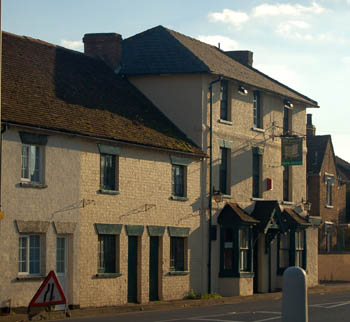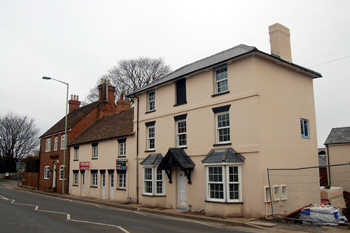The Beehive Public House Great Barford

The Beehive from east in October 2007
The Beehive Public House 11-13 Bedford Road, Great Barford
The Bedfordshire Historic Environment Record [HER] contains information on the county’s historic buildings and landscapes and summaries of each entry can now be found online as part of the Heritage Gateway website. The entry for the Beehive [HER16406] reads as follows: “The Beehive in Great Barford was established in 1850, it is a brick construction with a slate roof and is built over 3 storeys on a 3 bay plan. The second and third storeys have 3 sash windows and there is a band of plain stringcourse below each window, on the first floor this line is broken by the ground floor windows. The ground floor has a central gabled porch which is flanked by a canted bay window either side. Theses bay windows have tile hipped roofs and sash windows”.
The date given by the HER comes from the countywide licensing register of 1876. It lists two unnamed beerhouses, one in the occupation of Levi Hall, first licensed in 1850 the other in the occupation of John Robinson, first licensed in 1870. Robinson’s beerhouse only had a licence to sell beer for consumption off the premises, however meaning that Levi Hall’s must have been the Beehive.
In 1876 the Beehive was owned by William Sharp of Great Barford who leased it to Baldock [Hertfordshire] brewer, John Steed. Steed died in 1888 and he had obviously purchased the Beehive outright before his death because in 1889 his widow conveyed it to William Pickering of Baldock [GK165/4]. Pickering’s business was run Charles Morley, the firm being known as Morley and Company. By the time of the countywide licensing register of 1903 the Beehive was owned by Bedford brewer Charles Wells.
In 1920 Walter Molesworth Peacock carried out a number of surveys of licensed premises in North Bedfordshire for the magistrates [PK7/4/6]. One of them was the Beehive. It was still owned by Charles Wells and tenanted by William Thomas gamble, who had been there seven years. The brick and slate structure was categorised as “Good”, the decorative repair as “Fair” and the cleanliness as “Fair”.
Public rooms comprised: a tap room measuring 14 feet 9 inches by 11 feet 10 inches; a jug department and private bar measuring 15 feet by 11 feet and a cellar “capable of holding 8 barrels”. Private accommodation consisted of a kitchen measuring 12 feet 9 inches by 9 feet 4 inches, a small pantry, two bedrooms and two attics “one used as Sitting Room”. Outbuildings included a timber and tiled cart shed, a brick and slate range comprising stabling for two horses, piggeries and lofts over, a brick and tiled private closet, a brick and tiled public closet and a brick and slate washhouse fitted with a copper for heating water.
The Rating and Valuation Act 1925 specified that every building and piece of land in the country was to be assessed to determine its rateable value. Most of Bedfordshire was valued in 1927 and the valuer visiting the Beehive [DV1/C184/5] found it occupied by William Thomas Gamble who paid rent of £12 per annum and had “been here about 13 or 14 years”. The valuer commented: “Looks rather dirty inside”.
Accommodation comprised a “small” public bar, a tap room (“fair”), a cellar and a privy and urinal outside. Private accommodation consisted of a kitchen, three bedrooms and two attics. A privy, a washhouse with a copper for heating water and a sink, a four bay open hovel, three pig pens with a loft over and a pump lay outside.
Trade was one 36 gallon barrel of beer per week “the year throughout” and “say” a dozen pints of bottled beer with four dozen bottles of minerals. Tobacco sales consisted of half a pound of Saint Julian and a similar amount of Honeycutt, fifty Players cigarettes, 12 tins of Goldflake tobacco and two boxes of Woodbines per week.
At a later date the Beehive became a fully licensed public house. It was still a public house as late as October 2007 as the photograph below shows. By the time of writing however [2010] the public house had closed and become a private house.

The Beehive from west in October 2007
References:
- GK165/4: conveyed, with other properties by widow of Oliver Steed of Baldock to William Pickering of Baldock: 1889;
- PSB9/1: Register of Alehouse Licences - Bedford Petty Sessional Division: 1903-1935;
- PCGreatBarford30/3: postcard: c. 1908;
- Z1130/5/12: postcard: c. 1920;
- PK7/4/6: Evidence and report given by W.M. Peacock on Great Barford licenses - including details on trade, rental and license: 1920-1921;
- PSB9/2: register of licenses: c.1955-1995;
- Z53/5/12: photograph of Bedford Road, Cottage opposite Beehive Public House: 1960;
- PCGreatBarford30/3: transfer of licence: 1974
- PSBW8/3: Register of Alehouse Licences - Biggleswade and North Bedfordshire Petty Sessional Divisions: 1976-1980;
- PCGreatBarford9/3: disturbances outside the beehive: 1998-1999.

The former Beehive 11 and 13 Bedford Road March 2010
List of Licensees: note that this is not a complete list. Italics indicate licensees whose beginning and/or end dates are not known:
1876: Levi Hall;
1891: George Atkins;
1903-1905: George Henry Martin;
1905-1907: John Randall;
1907-1908: Thomas Bizley;
1908-1909: Reginald Smeathers;
1909-1913: Elijah Simkins;
1913-1933: William Thomas Gamble;
1933-1958: Harry Draper;
1961-1974: Robert Frederick Whiteman;
1974-1976: Ronald Johnson;
1976-1986: Richard Fegan;
1986-1991: Patrick Ryan;
1991-1994: Gareth Clive Goodby;
1994-1995: Janet Jose